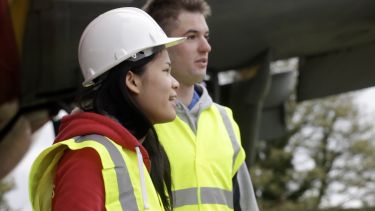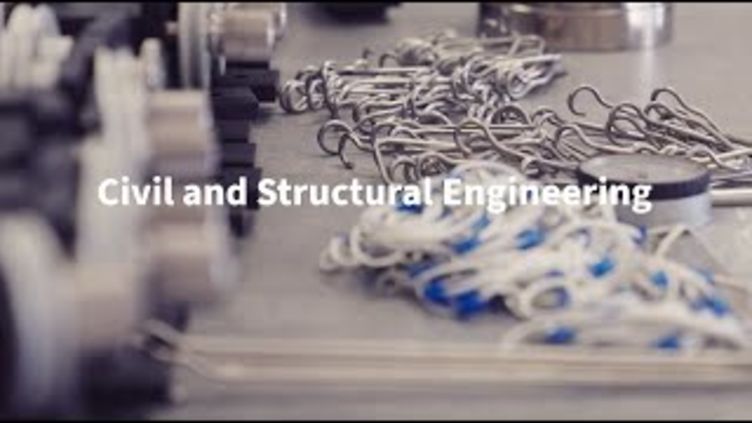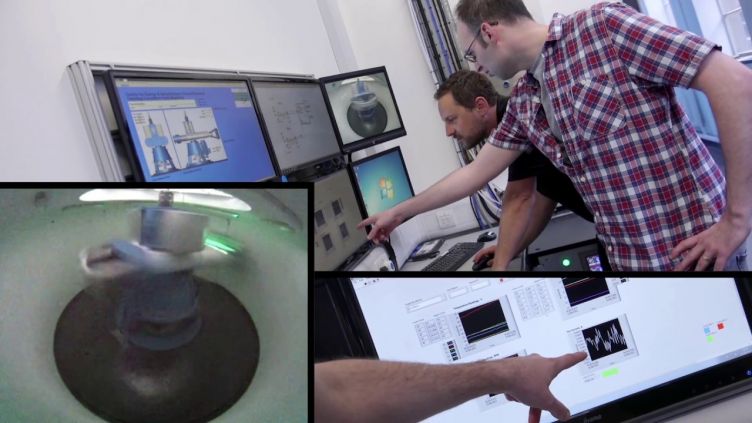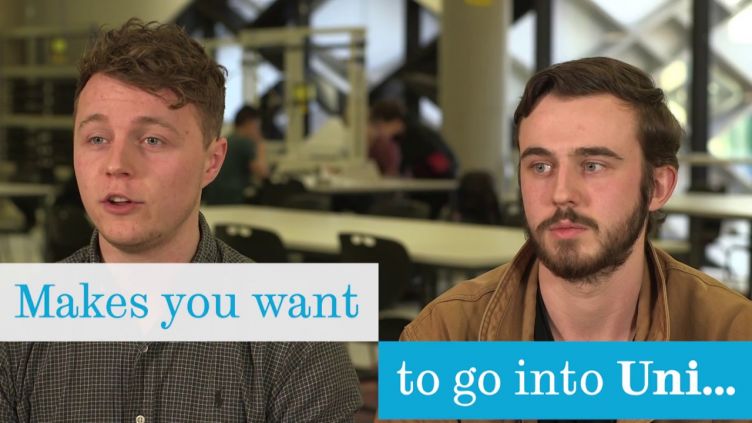Architectural Engineering MEng
This course combines subjects from all of the engineering disciplines associated with buildings and their infrastructure, as well as providing an understanding of architectural thinking and practice.
-
A Levels
AAA -
UCAS code
HK2D -
Duration
4 years -
Start date
September
- Accredited
- Course fee
- Funding available
- Optional placement year
- Study abroad option
Explore this course:
Course description
Why study this course?
Unique accreditation by CIBSE, IMechE and JBM
This degree supports a diversity of potential career pathways both within and outside of the built environment.
Unique multidisciplinarity of teaching
You’ll learn civil and mechanical engineering, and architectural thinking from specialists in each discipline.
World-leading research facilities
Get hands-on experience, including access to the unique urban flows observatory.
Project-based learning
Our series of design projects throughout each year allow you to integrate technical knowledge with more practical design considerations. You'll develop capability in tackling realistic projects and addressing complex challenges

Be part of the interface between structural and mechanical engineering, and architectural thinking and practice – ready to create the next generation of low environmental-impact buildings.
There is an increasing demand for building systems engineers with multidisciplinary skills. Study at Sheffield and you'll become the kind of engineer who recognises social responsibility and holistic thinking. Someone ready to step into a career creating buildings which make minimal impact on our environment.
In the second half of the course, you’ll unleash your creativity on a grand scale: devising plans for an entire urban regeneration project based on a real site in Sheffield. You'll investigate new methods and construction materials while focusing on passive design measures and low impact systems.
You’ll be exposed to advanced methods of analysis and simulation techniques for certain building services, particularly fluids, civil, structural and mechanical engineering.
You'll undertake an individual investigative project, developing your ability to work independently and carry out research.
These will feed into your major investigative project, developing your ability to work independently and carry out research.
You'll graduate with all the skills you need to contribute to the continuous development and innovation within the low-impact built-environment of the future.
This degree is accredited by the Chartered Institution of Building Services Engineers (CIBSE), Institution of Mechanical Engineers (IMechE) and the Joint Board of Moderators (JBM), comprising the Institution of Civil Engineers, Institution of Structural Engineers, Institute of Highway Engineers, the Chartered Institution of Highways and Transportation and the Permanent Way Institution, on behalf of the Engineering Council for the purposes of fully meeting the academic requirement for registration as a Chartered Engineer (CEng).
Find more information on the CIBSE and JBM websites.


Modules
UCAS code: HK2D
Years: 2026
Core modules:
- Mathematics and Python Programming
-
This module aims to reinforce and extend students' previous knowledge of mathematics studied before university, and introduces the use of computer programming to solve engineering and mathematical problems.
20 credits
Mathematics is further taught to develop new basic mathematical techniques needed to support the engineering subjects taken at levels 1 and 2. It also provides a foundation for the level 2 mathematics courses in the department. Combined with the mathematics teaching, this module teaches the opensource programming language, Python, which can be used to efficiently solve a variety of practical scientific and numerical problems.
A combination of formal lecture content, tutorials and assisted computer lab sessions, help the students learn and apply mathematical and programming theory. Practice problems are presented showing the links between mathematics and programming learning, to show how the skills learnt can solve practical problems of relevance to the students. - Fundamental Engineering Science: Part 1
-
In conjunction with a similar module that runs in the Spring semester, this module will provide you with the fundamental knowledge and understanding that will underpin the rest of your mechanical engineering degree. This module focuses on statics, solid mechanics and manufacturing processes; you will learn about these topics from first principles and observe them as phenomena in the laboratory. You will then have the opportunity to apply them to a practical engineering problem in a separate, concurrent integrative project module.
20 credits - Fundamental Engineering Science: Part 2
-
In conjunction with a similar module that runs in the Autumn semester, this module will provide you with the fundamental knowledge and understanding that will underpin the rest of your mechanical engineering degree. This module focuses on dynamics, fluids, gases and thermofluids; you will learn about these topics from first principles and observe them as phenomena in the laboratory. You will then have the opportunity to apply them to a practical engineering problem in a separate, concurrent integrative project module.
20 credits - Design Project 1: Make and Break
-
20 credits
Get ready to shape the future and build a better world from day one! This isn't just theory; it's where you'll dive straight into solving real-life problems and see your designs come to life with tangible results.
This dynamic first-year module introduces the essential knowledge and skills for 21st-century engineers. Through hands-on, interactive exercises, you'll develop critical thinking and problem-solving abilities, applying your practical maths and physics skills to real-world applications.
You'll explore concepts like systems thinking and risk management, and learn from case studies of iconic projects. We'll also spark your passion for sustainability, showing you how to design sustainable infrastructure and contribute to low-carbon construction.
You will work on exciting design challenges, and start to develop your project management skills. The highlight is a group practical project where you'll design, construct, and destructively test a physical structure. - Design Project 2: Sustainable Buildings
-
This module is where you'll move from initial concepts to designing complex infrastructure that addresses real-world needs and shapes the built environment.
20 credits
You'll begin with an intensive, interdisciplinary design project, to find a sustainable solution to an urgent societal problem. This immersive experience will rapidly advance your teamwork, detailed design, and communication skills.
Then, you'll dive into your main task: designing an entire building and its surrounding infrastructure. You'll synthesise your first-year engineering knowledge, informed by on-the-ground measurements, historical architectural precedents, and thorough site analysis. This is about creating holistic solutions that achieve a crucial balance of social, environmental, and economic needs.
You'll communicate your vision effectively using both hand sketching and computer-aided drawing in 2D and 3D. In this module you'll learn how to make a difference in communities and shape a better future for humanity and the planet. - Architectural Humanities 01
-
The course explores the reciprocal relationship between architecture, landscapes, the built environment and society, introducing a broad range of inhabitations and domestic settings across the world and across time. Through a multidisciplinary and cross-cultural approach lectures will examine how humans have approached their needs for shelter and inhabitation, and the relationship between domestic types and public life, both in the past and in the present. The relationship of buildings to landscapes across a range of scales is explored. The course seeks to establish that architecture and landscapes are socially contextualised through style, symbolic references, typologies, use, materiality, meaning, structure, layout, and form, and also through the framing of human activities and rituals. By adopting a global approach the course engages with broader questions of locality, exchange, and adaptability.
20 credits
The course examines how the field of architecture is positioned in relation to wider issues - in particular, climate breakdown. Neither architecture nor climate are simply technical phenomena: both are social, political, and cultural; both raise questions about resources, land, economics, labour, policy, infrastructure, and more. We will explore these entanglements starting from a series of building case studies, and moving outwards to explore the wider landscape, material and immaterial networks that constitute architecture and climate. You will begin to position yourself in relation to these and other networks, and reflect on how you might encounter them in your future. Lectures will relate the physical making of the modern world to political, social, and other constructions.
In your second year, you’ll continue to build your technical knowledge and skills, which you’ll apply in context within design projects.
Example core modules
- Geotechnical Engineering
- Mathematics and Applications
- Structural Analysis
- Thermofluids
- Design Projects
In your third year, you’ll enhance and refine your skills in advanced structural analysis and design, as well as consolidate your knowledge of key topics like building physics and thermodynamics, allowing you to complete a substantial research project.
Example core modules
- Advanced Structural Design and Appraisal
- Building Thermodynamics and Simulation
- Fluids and Computational Fluid Dynamics
- Research Project
In addition to the core modules, you’ll have a wide selection of specialist optional modules, depending on your chosen specialism to suit your interests and career plans.
Example core modules
- Parametric Modelling and Computational Design
- Reuse of Existing Structures
- Structural Dynamics and Applications to Vibration Design
- Engineering a Healthy Built Environment
- Group Design Project
Example option modules
- Blast and Impact Effects on Structure
- Structural Analysis and Design for Fire
- Sustainable Drainage and Green Infrastructure
The content of our courses is reviewed annually to make sure it's up-to-date and relevant. Individual modules are occasionally updated or withdrawn. This is in response to discoveries through our world-leading research; funding changes; professional accreditation requirements; student or employer feedback; outcomes of reviews; and variations in staff or student numbers. In the event of any change we will inform students and take reasonable steps to minimise disruption.
Learning and assessment
Learning
The following are the main learning and teaching methods implemented within the programme:
- lectures
- tutorials (and example classes)
- practical activities
- design classes
- coursework assignments (including oral, video and poster presentations)
- Individual Investigative Project (final year)
- integrative projects
- online resources
We've academic staff who are world-leaders in their respective fields and some have over 20 years’ experience in industry. Our staff experience demonstrates how engineering fundamentals are applied in practice through project work that mimics real-life situations. We also bring in leading industry experts to enhance and support our teaching and advise on our curriculum.
Assessment
Students are assessed via a mix of the following:
- examinations
- coursework assignments
- online tests
- reports
- group projects
- presentations
- design work
- dissertations
Entry requirements
With Access Sheffield, you could qualify for additional consideration or an alternative offer - find out if you're eligible.
The A Level entry requirements for this course are:
AAA
including Maths
- A Levels + a fourth Level 3 qualification
- AAB, including A in Maths + A in a relevant EPQ; AAB, including Maths + A in AS or B in A Level Further Maths
- International Baccalaureate
- 36, with 6 in Higher Level Maths; 34, with 6 in Higher Level Maths, and A in a science-based extended essay
- BTEC Extended Diploma
- DDD in Engineering + A in A Level Maths
- BTEC Diploma
- DD in Engineering + A in A Level Maths
- T Level
- Not accepted
- Scottish Highers + Advanced Higher/s
- AAAAB + A in Maths
- Welsh Baccalaureate + 2 A Levels
- A + AA, including Maths
- Access to HE Diploma
- Award of the Access to HE Diploma in a relevant subject, with 45 credits at Level 3, including 39 at Distinction (to include Maths and Science or Engineering units) and 6 at Merit + A in A Level Maths
-
GCSE Physics (or Combined Science) grade 6/B
-
Acceptable Maths subjects include Maths, Maths with Mechanics, Further Maths or Applied Maths, but not Statistics or Use of Maths. Pure Maths is only acceptable when combined with Physics
The A Level entry requirements for this course are:
AAB
including Maths
- A Levels + a fourth Level 3 qualification
- AAB, including A in Maths + A in a relevant EPQ; AAB, including Maths + A in AS or B in A Level Further Maths
- International Baccalaureate
- 34, with 5 in Higher Level Maths
- BTEC Extended Diploma
- DDD in Engineering + B in A Level Maths
- BTEC Diploma
- DD in Engineering + B in A Level Maths
- T Level
- Not accepted
- Scottish Highers + Advanced Higher/s
- AAABB + B in Maths
- Welsh Baccalaureate + 2 A Levels
- B + AA, including Maths
- Access to HE Diploma
- Award of the Access to HE Diploma in a relevant subject, with 45 credits at Level 3, including 36 at Distinction (to include Maths and Science or Engineering units) and 9 at Merit + A in A Level Maths
-
GCSE Physics (or Combined Science) grade 6/B
-
Acceptable Maths subjects include Maths, Maths with Mechanics, Further Maths or Applied Maths, but not Statistics or Use of Maths. Pure Maths is only acceptable when combined with Physics
You must demonstrate that your English is good enough for you to successfully complete your course. For this course we require: GCSE English Language at grade 4/C; IELTS grade of 6.5 with a minimum of 6.0 in each component; or an alternative acceptable English language qualification
Equivalent English language qualifications
Visa and immigration requirements
Other qualifications | UK and EU/international
If you have any questions about entry requirements, please contact the school.
Graduate careers
School of Mechanical, Aerospace and Civil Engineering
Our graduates work all over the world, from the UK to Australia and the USA. Recent graduates have gone on to work for AECOM, Arup, Atkins, Buro Happold, Eastwood & Partners, and Kier.
You'll be able to apply your knowledge and skills to fields as diverse as the built environment, sustainability and improving the environment.
In addition, architectural engineering graduates might go into a broad range of engineering areas ranging from building services to mechanical, electrical or acoustic engineering.
Or as a structural engineer, you'll be helping to shape the world around us. Structural engineers design and construct multi-storey buildings, bridges, sports stadiums, tunnels, airports and schools.
School of Mechanical, Aerospace and Civil Engineering
Department statistics
1st in the Russell Group for teaching on my course and learning resources
National Student Survey (NSS) 2024
UK top 10 for civil engineering
The Times and The Sunday Times Good University Guide (by subject) 2025
5th in the UK for civil engineering
The Guardian University Guide 2025
96% of our research is rated world-leading or internationally excellent
Research Excellence Framework (REF2021)
Civil and structural engineering is at the forefront of improving the way we live. Whether it's providing the facilities that keep our day-to-day lives running smoothly - from roads and railways to clean water supplies - or working to meet the ever-changing needs of our society in the areas of sustainability, renewable energy and climate change - by designing innovative buildings, you'll be helping to create and protect the world we live in.
Our courses will make you the kind of engineer the world needs right now; forward-thinking, interdisciplinary, environmentally conscious, and capable of the kind of complex thinking our rapidly changing society needs. Wherever you choose to start your career, you'll be in demand.
We're in the UK top ten for civil engineering, according to The Times UK University Rankings 2024. Our research is internationally recognised, with 96% of our research rated as world-leading or internationally excellent, according to the Research Excellence Framework 2021 (REF2021). Industry and government value our expertise.
Our industry partners contribute to teaching through lectures, design classes, projects and site visits. We work with leading consultants, contractors and specialist civil engineering companies to provide industrial opportunities for a number of students each year. We also have industrial tutors and professionals who mentor our first-year students.
You'll be taught in The Diamond, one of the best teaching spaces in the UK.
Facilities
The Diamond is home to dedicated laboratories and facilities such as our structures and dynamics lab, fluids engineering lab, and our thermodynamics and mechanics lab. This means you'll directly apply what you’ve learnt in lectures to lab sessions helping you to put theory into practice. Alongside teaching and study spaces, the Diamond is also home to iForge – the UK's first student-led makerspace.
University rankings
A world top-100 university
QS World University Rankings 2026 (92nd)
Number one in the Russell Group (based on aggregate responses)
National Student Survey 2025
92 per cent of our research is rated as world-leading or internationally excellent
Research Excellence Framework 2021
University of the Year for Student Experience
The Times and The Sunday Times Good University Guide 2026
Number one Students' Union in the UK
Whatuni Student Choice Awards 2024, 2023, 2022, 2020, 2019, 2018, 2017
Number one for Students' Union
StudentCrowd 2024 University Awards
A top 20 university targeted by employers
The Graduate Market in 2024, High Fliers report
Student profiles

Being a small part of such a grand project really was the highlight – it truly is a once-in-a-lifetime opportunity
Jay
Placement with Arup,
MEng Architectural Engineering with an industrial placement

My course offers a blend of skills and knowledge to be able to understand buildings in a holistic manner
Hasan
MEng Student,
MEng Architectural Engineering
Fees and funding
Fees
Additional costs
The annual fee for your course includes a number of items in addition to your tuition. If an item or activity is classed as a compulsory element for your course, it will normally be included in your tuition fee. There are also other costs which you may need to consider.
Funding your study
Depending on your circumstances, you may qualify for a bursary, scholarship or loan to help fund your study and enhance your learning experience.
Use our Student Funding Calculator to work out what you’re eligible for.
Placements and study abroad
Placement
Study abroad
Visit
University open days
We host five open days each year, usually in June, July, September, October and November. You can talk to staff and students, tour the campus and see inside the accommodation.
Online events
Join our weekly Sheffield Live online sessions to find out more about different aspects of University life.
Subject tasters
If you’re considering your post-16 options, our interactive subject tasters are for you. There are a wide range of subjects to choose from and you can attend sessions online or on campus.
Offer holder days
If you've received an offer to study with us, we'll invite you to one of our offer holder days, which take place between February and April. These open days have a strong department focus and give you the chance to really explore student life here, even if you've visited us before.
Campus tours
Our weekly guided tours show you what Sheffield has to offer - both on campus and beyond. You can extend your visit with tours of our city, accommodation or sport facilities.
Apply
The awarding body for this course is the University of Sheffield.
Recognition of professional qualifications: from 1 January 2021, in order to have any UK professional qualifications recognised for work in an EU country across a number of regulated and other professions you need to apply to the host country for recognition. Read information from the UK government and the EU Regulated Professions Database.
Any supervisors and research areas listed are indicative and may change before the start of the course.



